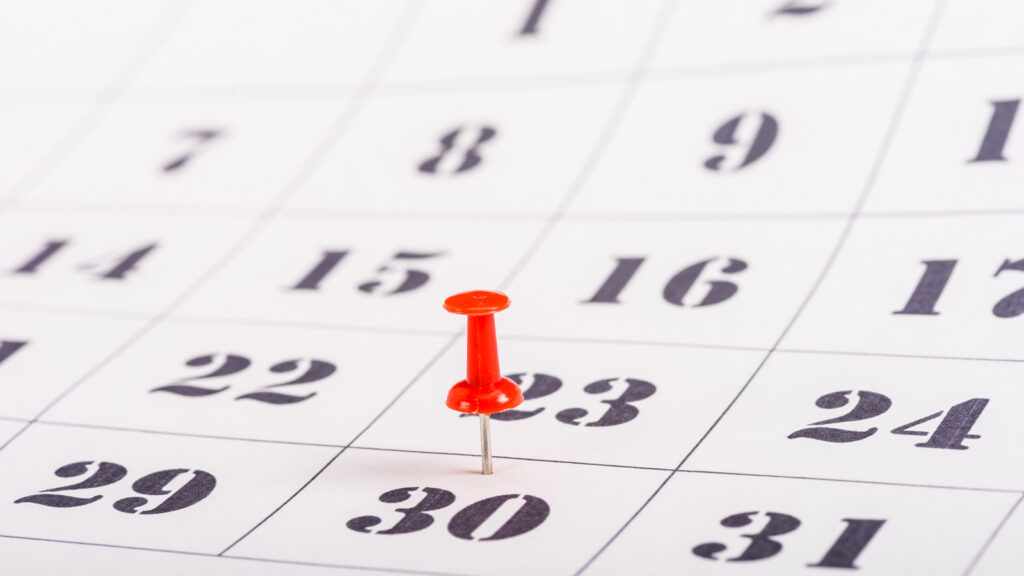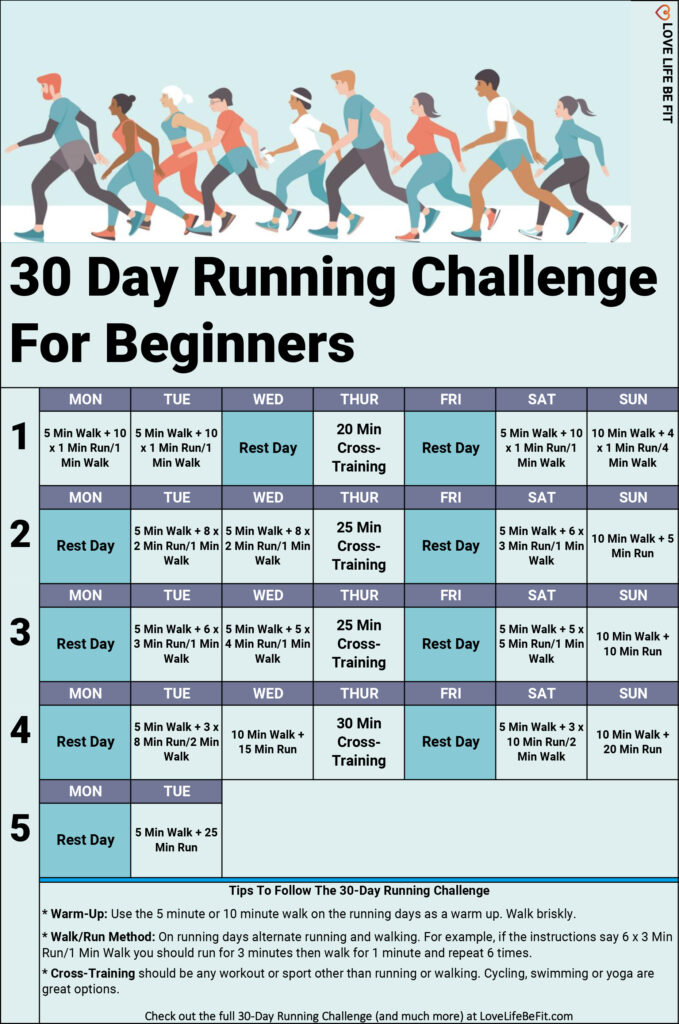30 Day Running Challenge For Beginners + Download Free Plan
Think you’ll never be able to start running or maybe it’s a long time since you called yourself a runner. Then this 30 Day Running Challenge For Beginners is for you. It’s a plan to prove that just about anyone can run even if you’re overweight or completely out of shape.
The plan starts gently with walking breaks and rest days to ease you into running. You’ll gradually increase your running time each week until you can comfortably run continuously for 25 minutes.
This 30 Day Running Challenge will get results for weight loss and improve your cardiovascular fitness. But just be warned! At the end of the challenge, you may find you’ve caught the running bug and there’s no going back…

What is the Love Life Be Fit 30 Day Running Challenge?
It’s a 30 day training program based around the routine of a typical running plan. There are 4 running days a week, one cross-training day, and two rest days.
The run sessions are 25 to 35 minutes in length and alternate walking and running for the first few weeks.
Is The 30 Day Running Challenge Suitable For A Beginner Runner?
Yes of course! The training schedule is aimed completely at beginners and it’s designed to help you start running.
The entire challenge assumes you’re a non-runner starting from a low fitness level. In the first week, you’ll run for no more than a minute at a time between walking rests.
The run intervals gradually build but the sessions are based on time spent running rather than running speed or distance. You’re running at your own pace.

The Love Life Be Fit 30 Day Running Challenge For Beginners
This plan is aimed at complete beginners and includes 4 running sessions a week plus one cross-training session to build a good running base. It’s a realistic way to increase your run time to 25 minutes without stopping by the end of the 30 days.
If 5 days of training a week seems too much, we suggest you try our other training plans for beginners. The Couch to 5K plan has a steadier build-up with 3 running days a week.
You can pin the image below to save it or download a FREE printable version here. The printable version has check boxes so you can record your progress. We suggest you pin it up somewhere you’ll see it every day such as by your desk or maybe on the fridge!

Download The Free Running Program
What Are The Goals Of The Challenge?
The running goals will be unique to you but the main aim of the challenge is to help you build a regular running habit. At the end of the month, you should be able to run consistently – as much as 25 minutes without stopping! Won’t that be amazing?
The goal is to improve your fitness. It will boost your cardiovascular system and you may lose weight. Find out more about running for weight loss.
At the end of the 30 days expect to experience some of the many benefits of running from more energy to a better immune system and improved moods.
Will You Lose Weight?
The 30 Day Running Plan will challenge your body and burn extra calories. You can estimate how many calories you’ll burn using our Calories Burned Running Calculator. Your current body weight will determine how many calories you’ll burn.
Most people will lose 1 -2 pounds a week by taking part in the running challenge but your weight loss will depend on what you eat.
For best results try and follow a healthy diet. If running makes you hungry, fill up on high-fiber whole grains, vegetables, lean protein, some fruit, and healthy fats.
Rewarding your efforts with high-fat sugary treats will quickly replace the calories burned. Instead, keep some healthy snacks to hand for when the munchies hit!

Getting Started
Running is an accessible way to exercise but there are a few things you need to do before you start running:
- Get a check-up: if you’re carrying a lot of excess weight, it’s years since you last exercised or you have any underlying health issues, get the all-clear from your doctor before you start the running challenge.
- Invest in some proper running shoes. It’s best to get fitted for your first running shoes at an independent running store with knowledgeable staff. Find out more about why you need good running shoes.
- If you’re a woman, use a sports bra. A running bra with good support is essential even for smaller cup sizes. Otherwise, you risk damaging the Cooper’s ligaments that support the breasts. It can also be painful running without a good sports bra.
Get some more tips for how to start running.
The Run/Walk Method
The running challenge for beginners uses the run/walk method to ease you into running continuously. In the first week, you’ll alternate 1 minute of running with 1 minute of brisk walking. As the weeks progress, the running intervals will get longer and the walking intervals will get shorter.
There are good reasons for this run/walk approach…
Running is hard work when you’re a complete beginner
Your first run is going to hurt even with the walk breaks. But hang in there – running does get easier.
The walk breaks will give you time to get your breath back
While running is good for your heart health, it can be harmful to push too hard. Walk breaks give your heart rate time to recover.
Signs that a person is pushing their heart too far include chest tightness, difficulty breathing, and a relative inability to talk while running.
If this happens to you slow down and concentrate on getting your breathing back to normal. If you have any chest pain or chest burning sensation get medical advice immediately.
Start your running intervals at a slow jog. It should be a conversational pace where you can run and talk. They’ll be plenty of time to try running faster as you get fitter.
It’s easier on your joints and muscles.
Running is a high-impact activity. Most new runners lack the strength to cope with running continuously for more than short intervals.
The Run/Walk method gives your joints and muscles a chance to recover during the lower-impact walking breaks.
Even if you’re starting the plan from a good fitness level, it’s a good idea to use the run/walk method when you start running. You’re giving your leg muscles and joints a chance to adapt to the stresses of running.
Doing too much too soon can lead to injury. Listen to your body and if you have any persistent niggles get them checked out by a medical professional.

Proper Running Form
Running may be a natural activity but by the time we’re adults we’ve picked up lots of bad habits and almost forgotten how to run.
Helpful tips for running form are standing tall and engaging your core so that your hips don’t sag, using your arms properly, and landing with your feet under your body.
Find out more about how to become a better runner.
Why Does The 30 Day Running Challenge Include Cross-Training?
Cross-training helps to improve your strength and fitness but gives your body a rest from the impact forces of running. It complements your running and can make you a stronger runner.
By alternating between different activities, you’re allowing your body time to recover from the repetitive impact of running. As a result, you’re building endurance and aerobic fitness without getting sidelined by an injury.
Cross-training can help with muscle imbalances. Most runners have a dominant leg and mixing up your workouts can help to strengthen neglected muscles.
Suitable cross-training activities for runners include swimming, cycling, weight training, climbing, and yoga. If you’re not used to these activities then take it steady and build up gradually.
It’s best to stay away from activities with fast movements and changes of direction. These can put too much strain on your joints.
Find out more about cross-training for runners.

Strength Training
The quickest way to make progress as a new runner is to add runner-specific strength training sessions to your training plan.
We strongly advise you to add 2 short 10-15 minute strength training workouts to the 30 Day Running Challenge. The best times to add these sessions are after the cross-training on Thursday and after the running session on Sunday. This will give you a rest day to recover.
You don’t need any special equipment, these bodyweight exercises for runners are ideal.
The post includes video links to make sure you’re doing the workouts correctly and strength training tips for regressions if you find the exercises too challenging.
You can break up the exercises into two sessions:
Session One
- Single-Leg Glute Bridge
- 90 90 Push Backs
- Split Squats
- Reverse Lunges
- Single-Leg Deadlifts
Session Two
- Side Plank Leg Lift
- Supermans
- Plank
- Windshield Wipers
- The Squat
- Single Calf Raises

Why Does The Challenge Have Rest Days?
Some running challenges include daily workouts and running every day. This can work for intermediate runners who have built up some strength and resilience, but for beginner runners, rest days are extremely important.
Your muscles, joints, and connective tissues need time to recover and repair between sessions. It’s your protection against sustaining running injuries.
Even experienced runners benefit from some downtime. Running two miles every day or running 5 miles a day can help runners stay focused. However, it’s difficult to improve as a runner without rest days.
Adequate rest and recovery will help you return to training feeling stronger and full of energy.
The running challenge for beginners includes two full rest days. At this stage in your training, these days should be complete rest.

Tips To Complete The 30 Day Running Challenge For Beginners
Follow these beginner tips to stay motivated and successfully complete the 30 day running challenge.
#1 Run At A Slow Pace
It’s always easy to get carried away and set off too fast. Start the challenge running at a slow pace.
You should be able to talk and run – if not you’re running too fast.
#2 Practice Your Breathing
Getting your breathing right can be a real challenge for a new runner. These tips will help you practice your breathing.
#3 Pre-Plan Your Running Routes
It helps to know where you’re going to run. You can vary your running routes to keep your sessions interesting. Just make sure you don’t run too far from home and find yourself with a long walk back!
Some people prefer to run on a treadmill and it can be a good option for running on hot days or if you want to avoid running in the rain.
#4 Stay Accountable
Sometimes you need a little help to stay motivated. Try running with a buddy or print out the running challenge for beginners and stick it somewhere you’ll see it every day.
#5 Schedule Your Runs
It can help to complete your workouts at the same time every day. If that’s not possible schedule your runs to make sure they get priority.
If you’re a morning person it can help to run first thing before the distractions of the day take over. Other people prefer to run later in the day when your body’s early morning stiffness has worn off.

#6 Accept Some Days Will Be Tough
There will always be days when you don’t want to workout. All runners feel this way.
The best tip is to start your exercise session. Ease into it gently and once you’ve fully warmed up you’ll probably feel a lot better.
If you’re really tired, it’s okay to cut your workout short but just make sure you give it a go first.
#7 Respect Your Body And Feed It Good Food
You wouldn’t put substandard fuel in your tank – so don’t do the same to your body. Start taking an interest in nutrition.
When you’re a regular runner you need sufficient nutrients to stay healthy and train properly. Learn how to eat better.
#8 Enjoy Your Running And Believe In Yourself
Running should be fun! It may not feel that way during the first few sessions but aim to get to the 9th run. That’s enough for running to start to feel a little easier and for your body to adjust to your new regime.
Believe in yourself! Dig deep and you can achieve more than you think.

Thoughts From Love Life Be Fit
Hopefully, this 30 day running challenge for beginners will get you started on your running journey. At the end of the plan, you should be fired up to continue running 3 to 4 days a week. For more ideas take a look at this post Fun 30 Day Running Challenges or try our Running A Mile A Day Challenge.
Your next step could be completing a 5K race or fun run (Parkruns are ideal for new runners), and then training for a 10K.
If you have a lot of weight to lose and your fitness level is very low, we suggest you start with our 30 Day Walking Challenge first. Then when you’re fitter, you can then progress to the running challenge. Get more tips about how to start running when overweight and out of shape.
Running 101 Training Guides & Walking Schedules
5K Training Plans
- Couch To 5K Beginner Training Plan
- 12 Week 5K Training Plan
- 10 Week 5K Training Plan
- 8 Week 5K Training Plan
- 6 Week 5K Training Plan
- 4 Week 5K Training Plan
- 5K Training Plan Intermediate





